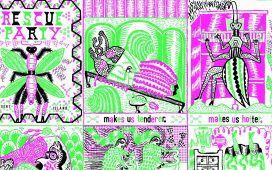The U.S. system was also unique in that no other country required a model to accompany a patent application. The reasons why soon became clear. As early as the eighteen-thirties, the collection had outgrown the Patent Office’s cramped headquarters at the former Blodgett’s Hotel. In 1836, a fire destroyed at least seven thousand models, but, rather than abandon the requirement, the Patent Office doubled down, securing congressional funding to reconstruct the models and laying the foundations for a truly monumental building, with a façade modelled after the Parthenon. The structure, which now houses the Smithsonian’s American Art Museum and the National Portrait Gallery, occupies an entire city block. In the engineer Pierre L’Enfant’s master plan for the capital, it was intended to serve as a kind of nondenominational “church of the republic,” between the White House on one side and the Capitol on the other.
In a way, devoting such a titanic structure to the display of delightful gizmos fulfilled this vision. The model gallery was regarded as a fitting testament to American democracy, demonstrating “the ingenuity of a free people,” as the Pittsfield Sun put it. But the Civil War marked the beginning of the end. At first, the models merely acquired new neighbors: the building became a hospital. “It was, indeed, a curious scene,” Walt Whitman wrote, describing the “high and ponderous glass cases, crowded with models in miniature of every kind,” interspersed with “rows of sick, badly wounded and dying soldiers.” As the war left a trail of new technologies in its wake, the volume of patent applications skyrocketed, and the long galleries were augmented with balconies to provide yet more display space. Samuel Sparks Fisher, who became the Commissioner of Patents in 1869, pointed out that “it must soon become a serious question to determine what disposition is to be made of the models.” The next year, Congress passed new legislation, dropping the requirement for models; a few years after that, the general public was banned from the building, owing to space constraints. The doors of the Temple of Invention began to swing shut, seemingly for good.
The remaining challenge was what to do with the thousands of existing models. They were jammed into corridors and hallways, “haphazardly placed on filing cabinets, desks, book shelves, under chairs, any available space,” according to Bill Ray, a former Life staff photographer who published a guide to the models in the nineteen-seventies. Another fire, in 1877, did away with about a third of the collection. Later, the Smithsonian agreed to accession the thousand it deemed most important—“chosen by someone who only knew or cared about sewing machines,” Ray complained. The rest were boxed up and stored in a series of rented buildings, basements, and even an old livery stable. Finally, in 1925, Congress realized that it had spent at least two hundred thousand dollars moving and storing patent models during the prior forty years, and appropriated another ten thousand to get rid of them once and for all.
A few thousand were returned to the inventors or their heirs, and the Smithsonian eventually claimed a similar number, but the rest were bought, in bulk, by the wealthy pharmaceutical entrepreneur Sir Henry Wellcome, who planned to establish a dedicated patent museum. The Depression deferred that dream, and when Wellcome died the models were sold to Crosby Gaige, a Broadway producer. As Alain Pottage and Brad Sherman recount in “Figures of Invention,” their history of modern patent law, Gaige “staged the opening of selected boxes as a kind of performance for which the public was charged an admission fee”—a form of entertainment that somehow met with “considerable initial success.” Nonetheless, the public appetite for model-unboxing was quickly sated, and, by 1942, the surviving models were scattered to collectors far and wide.
Cascio told me that Hagley began collecting patent models in the early nineteen-sixties; the museum now has the largest private collection in existence. A little more than a hundred are currently on display; thousands more, in varying states of conservation, are shelved in a storage room near the estate’s Christmas decorations. Much of the collection remains uncatalogued. Cascio, a fifty-year-old historian, joined the museum just a few years ago, and told me that, with two thousand models left to process, he expects to retire before the job is done. Every so often, when he opens a box, he finds an item that has lost its label and any other identifying marks. These mystery models—Cascio has come across more than two hundred already—are kept in a separate storeroom near his office, where he occasionally goes to wonder, What the heck does that thing do?








